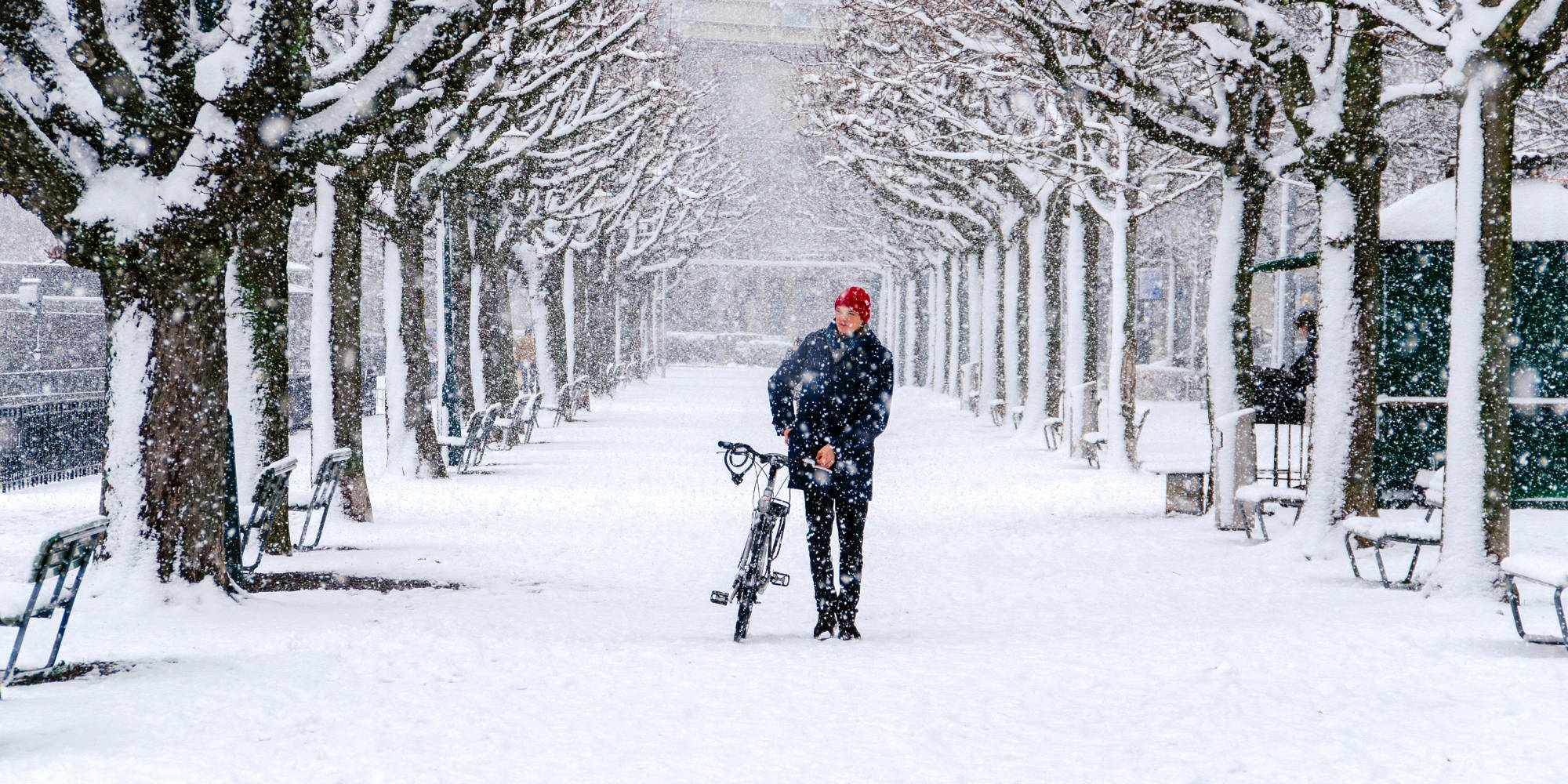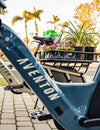
Ebike Winter Storage and Use Best Practices
November 21, 2023
Winter is fast approaching and you may be wondering what to do about your electric bike storage over the winter. Maybe you want to continue your newfound and fun form of exercise, and are wondering if you can ride an ebike during the brisker, wetter months of the year. Or maybe you're wondering about e-bike storage for such an extended period of time.
Here at Aventon we’ve got you covered in both scenarios, with all the tips, tricks, and easy e-bike storage solutions you need to feel confident about riding and storing your ebike and any additional parts through the winter months. This is what we'll be diving into:
Storing Your Electric bike For The Winter
Ebike storage either during or for the winter means that you’re going to be storing it for a prolonged period; not just 4 - 5 days like you usually might. Winter also brings the threat of extreme conditions, prolonged rain or snow, and extremely low temperatures. These factors all need to be taken into account when considering ebike winter storage.
Here’re some best practices regarding e-bike storage during the winter:
Clean Before Storing
Aventon ebikes are IPX4 water-resistant. This means you can clean your bike with a bucket and sponge, but should avoid using pressurized water.
Clean all dirt off your frame, then wipe it down with a dry cloth. Make sure to check that the battery contacts are clean and dry to prevent corrosion. Afterwards, lube the chain to protect it and turn the pedal to rotate the chain to ensure that the lube circulates around the system.
Ebike Storage
Electrical devices and components in e-bikes are sensitive to extreme temperatures. Store them in a cool, dry space, away from high humidity. A garage or outdoor shed is a good idea depending on where you live.. The ideal storage temperature is between 32º and 68º.
While your bike will stay dry during the long winter months in a garage or outdoor shed, the biggest enemy to your ebike and its components is high humidity. This will still cause some potential rust and corrosion over time. To prevent this, invest in a bike cover for added protection.
Storing Your Ebike Battery & LCD Screen
Store batteries and LCD screens in a cool, dry place to prevent freezing. Keep batteries near room temperature for optimal performance, as extreme temperatures can damage their chemistry. According to a Sciencedirect.com article on lithium-ion batteries, it's advised ebike battery storage temperature should avoid sub-zero temperatures for the best efficiency.
Aventon batteries are lithium ion, and should never be stored with their charge level completely depleted. Doing so means they might be unrecoverable after storage. For best performance store your battery at a 75%-80% charge level. Check the charge level on a monthly basis and make sure that the percentage doesn’t drop under 75%. This will help extend your battery's life.
Do not store Aventon batteries on their charger or attached to your ebike.
Winter Pre-Ride Checklist
After storing your ebike for the winter take it to your local bike shop for a tune up. Have them make sure your brake and gear lines are working properly, and your brake pads, chain lube, gear shifting, and other items so that you have a safe and operational bike.
After your tune up, take your bike for a short test ride to make sure everything is functioning properly. Check the brakes, the gears and ensure that everything is how you like it. If you find anything wrong just head back to the bike shop where they’ll be happy to put things right for you.
Check Your Tires
In adverse conditions, your ebike needs to be the best it can be. Your tires are your contact with the ground so it is important that they’re in top condition. The tread on your ebike tires will wear, just like those on your car. Check your tires periodically throughout the year and especially during the winter.
Protect You & Your Bike with Fenders
Fenders are a good idea to have in general, but if you don’t have them you’re going to want them for winter riding. Fenders will protect you, your clothes, your bike, and your battery from dirt and debris kicked up by your tries. Not only do they provide this protection but not having this material flying up toward you makes for a much more comfortable ride.
Wear a Helmet And Protect Your Head
It goes without saying that you should always ride with a helmet. Especially once the conditions start to get worse and the daylight fades quicker.
Layer Up
If you plan on riding in the snow or winter climate conditions, wear the proper clothing. Layering with the right gear can prevent you from sweating and promote a warmer ride:
- Base layer - Long polyester underwear, tops and bottoms, can wick the sweat off your body.
- Middle layer - Sweater or jacket made with synthetic lining to retain body heat and protect you from the cold.
- Outer layer - A waterproof or breathable rain jacket shields you from the cold wind, rain, or snow
Water-resistant shoes will also keep your feet dry. Bring two pairs of gloves, a lighter pair and a heavier duty pair, in case it gets colder. Sunglasses will protect your eyes from the harsh reflection of sunlight off the white snow. And don’t forget sunscreen and chapstick too!
Knee & Elbow Pads
Some riders wear pads year-round, others opt for them during wintertime and in the presence of hazardous conditions. Water and ice can make roads and trails slick and slippery. Black ice can be a hazard on the road in colder climate conditions. Protect your joints with a set of knee and elbow pads.
Using Your Ebike During The Winter
As previously mentioned, Aventon ebikes are IPX4 water-resistant. So if you’re thinking about continuing to use your ebike to commute during the winter months, go right ahead!
And if you don’t commute by ebike, and think you’ll want to ride during colder weather, make sure your battery is fully charged before taking it on a short test ride to test the brakes and gears before you set off on a longer, more adventurous trip.
Pro Tip: In Nordic countries where it reaches severe cold temperatures, people bring their bikes out for a bit before riding because if the frame is the same temperature as outside, snow won't melt and stick to the frame as much or at all. This will keep your frame clean and prevent rust.
Here are a few things to take into consideration when it comes to riding during Winter.
Only Ride In Safe Weather Conditions
Only use your ebike if you’re absolutely sure you can ride it under the prevailing conditions. Your safety is paramount, and even if you’ve taken all the precautions, there will be days you might want to consider commuting using an alternate method.
Braking Is Different
Ebikes tend to be heavier and faster than regular bikes so, naturally, they will take longer to stop. This means you need to brake sooner especially in slippery conditions. When there is water or ice on the road this reduces friction. Practice safe braking by increasing your stopping distance.
Improve Visibility with Headlights
The winter days are much shorter and you don’t want to get caught out in the dark. For safety purposes make sure that you have front and rear lights on your ebike. Not only so that you can see where you’re going but so you can be seen as well.
Stay Seen with Reflectors
Reflectors are there to reflect the lights of other vehicles to let them know you’re there. They won’t replace lights, but they’re an excellent tool for bringing your presence to the attention of others. The ones which fit between the spokes of your wheels work well, especially when crossing side roads. Reflectors don’t just have to be on your bike. You can buy fluorescent and reflective clothing and reflective stickers too.
Keep Your Ebike Clean
It is an excellent practice to clean your ebike after every use. This becomes even more significant on rainy days where your bike is more likely to have gotten wet and dirty. Simply wiping your ebike down after each trip can prolong its life and ensure that it stays free from rust. When doing this make sure to dry wipe the contacts where the battery connects to the bike, ensuring this integral part of your ebike stays in optimal condition.
Pro Tip: Don't forget to immediately wash off any salt if your route takes you on salted roads. This will prevent damage to even the best frames.









To add an extra layer of protection to your Ebike during the winter months buy a good bike cover that is heavy duty quality the fabric should be at least 200 denier or greater, if you can get a cover that is 500 denier like a BBQ grill cover it will provide the best protection during storage.
Good rundown on winter storage. Thanks.
Hello. I will be storing both our pace 500’s in North Carolina starting November 1st until February 1st in a storage unit. It does get down to freezing here. Can I wrap the batteries in towels during this time to protect them from the extreme cold? Thanks
Hello. I will be storing both our pace 500’s in North Carolina starting November 1st until February 1st in a storage unit. It does get down to freezing here. Can I wrap the batteries in towels during this time to protect them from the extreme cold? Thanks